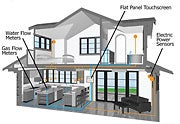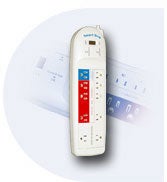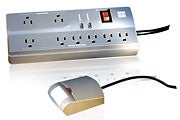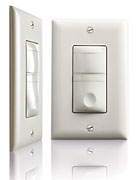Green Tech: Save the Planet the Easy Way Make "reduce, reuse, recycle" a breeze with new gadgets and technology tips for your home, your gear, and the rest of your life.
By Erin Biba
Going green is in, but how easy is it to do? Many small changes that you can make in your everyday life will add up to a big impact on the environment--and you don't have to buy a Toyota Prius to accomplish them. In many cases, it's a matter of getting a gadget to do the hard work for you. Here are ten steps you can take with technology to help save the planet.
Reduce
Before you can keep track of how successful you are at reducing your impact on the environment, you need to know what your impact is. A slew of gadgets, gizmos, and software programs can get you started.

It's possible to modify your entire house to monitor its energy use. Agilewaves Resource Monitor links a flat-panel touch screen with your home's power, water, gas, and temperature systems. The panel lets you access real-time usage data (and time-lapse data) by floor, room, individual appliance, or specific utility. You can also access the Internet with it, of course.

If you don't have the big bucks to drop on digitizing your house, consider a simpler alternative. You can plug P3 International's Kill A Watt ($40) into any electrical outlet and then plug the appliance you want to measure into Kill-A-Watt. The device measures kilowatt-hours of energy and tells you how much the appliance costs to run.
Of course, the point of monitoring your energy intake is to help you waste less power. Here are some painless ways to cut back:
PC: A typical PC consumes 600 kwh of electricity every year. Software can help you reduce that expenditure. Most programs, like Verdiem's Surveyor , automatically shift your computer to its lowest power settings when the machine isn't not in use.
 Monitor: Energy Star , a joint program of the U.S. Environmental Protection Agency and the U.S. Department of Energy, recommends shutting your monitor down after 5 minutes of inactivity. Conveniently, Energy Star provides a link on one of its pages to a Computer Management Savings Calculator, which includes a monitor component. The site also offers drop-down lists of Energy Star-qualified monitors from various vendors on its Monitors page . Finally, for a downloadedable PowerPoint presentation of the program's guidelines for qualifying monitors, see " Proposed Energy Star Specifications for Computer Monitors ."
Monitor: Energy Star , a joint program of the U.S. Environmental Protection Agency and the U.S. Department of Energy, recommends shutting your monitor down after 5 minutes of inactivity. Conveniently, Energy Star provides a link on one of its pages to a Computer Management Savings Calculator, which includes a monitor component. The site also offers drop-down lists of Energy Star-qualified monitors from various vendors on its Monitors page . Finally, for a downloadedable PowerPoint presentation of the program's guidelines for qualifying monitors, see " Proposed Energy Star Specifications for Computer Monitors ."
The Web: Some authorities contend that the amount of energy a cathode-ray tube monitor uses depends on the color it displays. According to the Department of Energy , for example, a white screen uses 74 watts of power, while a black screen uses only 59 watts. So you may be able to save power by using a black Google screen such as those offered by Google-Black , GreenerGLE , Earthle , and Darkoogle for your searches. Similarly, you can display Word documents as colored text on a black background. Or enable a starry night screen saver.
Use less paper: Even if "print less" is not an option for you, you can reduce your paper use by 4.75 percent: simply by changing your margins . The standard Microsoft Word document sets the margins at 1 inch on the top and bottom of the page, and at 1.75 inches on each side. Reducing those margins to .75 inch each saves paper, money, and trees.
 Plug in to efficiency : Your computer, monitor, printer, or other electronic hardware sucks power out of your outlets even when it's inactive. The best solution is to plug each component into a device that prevents useless power drain. BITS Limited's Smart Strip ($33) powers your PC and your peripherals at the same time. And when you turn off your PC, the strip automatically suspends power to all other devices you aren't using.
Plug in to efficiency : Your computer, monitor, printer, or other electronic hardware sucks power out of your outlets even when it's inactive. The best solution is to plug each component into a device that prevents useless power drain. BITS Limited's Smart Strip ($33) powers your PC and your peripherals at the same time. And when you turn off your PC, the strip automatically suspends power to all other devices you aren't using. 
Another option, Watt Stopper's IDP-3050 power strip ($40 at Web retailers), has a motion sensor that turns its outlets on when the strip senses someone in the room--and off when no one is there.
More Ways to Reduce
More Ways to Reduce

Outdoors: Water conservation is becoming a major issue. WeatherTrakprovides a service to regulate your lawn-watering system, reducing water use and runoff. The company's irrigation system will automatically schedule watering based on the soil type and slope of your lawn along with data gathered from local weather stations and NOAA satellites.
Get money to conserve: Various state, local, and federal entities have established incentives for switching to renewable energy or boosting your energy efficiency. Use DSIRE, the Database of State Incentives for Renewables and Efficiency, to find out what else you can do to reduce your use (and get some rebates, grants, and tax deductions while you're at it).
Reuse and Recycle
Technology enthusiasts tend to buy lots of new gadgets. But instead of dumping the old ones, why not recycle them?
PCs: Perhaps the best thing you can do with an old computer is to donate it to a charity that will reuse it. Some local United Way chaptersgive refurbished computers to schools and families in need. Another option is to donate your computer to a Microsoft Authorized Refurbisher, which will ultimately give your computer to a charity, nonprofit organization, school, or public library.
Cell phones: There are lots of ways to recycle phones, PDAs, cell phone batteries, chargers, and related accessories (some companies will even take your old appliances and other electronics). You can drop off old mobile phones at Best Buy, Office Depot, or Staples. Or you can mail out-of-date handsets back to Sprint, T-Mobile, Samsung, or Motorola. The Environmental Protection Agency maintains a comprehensive listof providers and retailers that operate recycling programs.
Everything else: The EPA keeps track of recycling, donation, and refurbishment programs for just about anything that requires electricity to run. Check out the master list at the EPA's eCyclingWeb site.
When Buying New, Go Green
Another essential aspect of energy use conservation involves looking ahead. Every time you buy something new, make sure it's green. Here are a few low-power toys to get you started:


Light up less: Replacing the light bulbs in your house with compact fluorescent light(CFL) bulbs can reduce your energy use for lighting by 75 percent (CFLs last about 10 times longer than standard incandescent bulbs, too). Or go a step further and get Motionbulbs ($20)--CFLs equipped with motion sensors that turn on when you enter a room and turn off when you leave.












